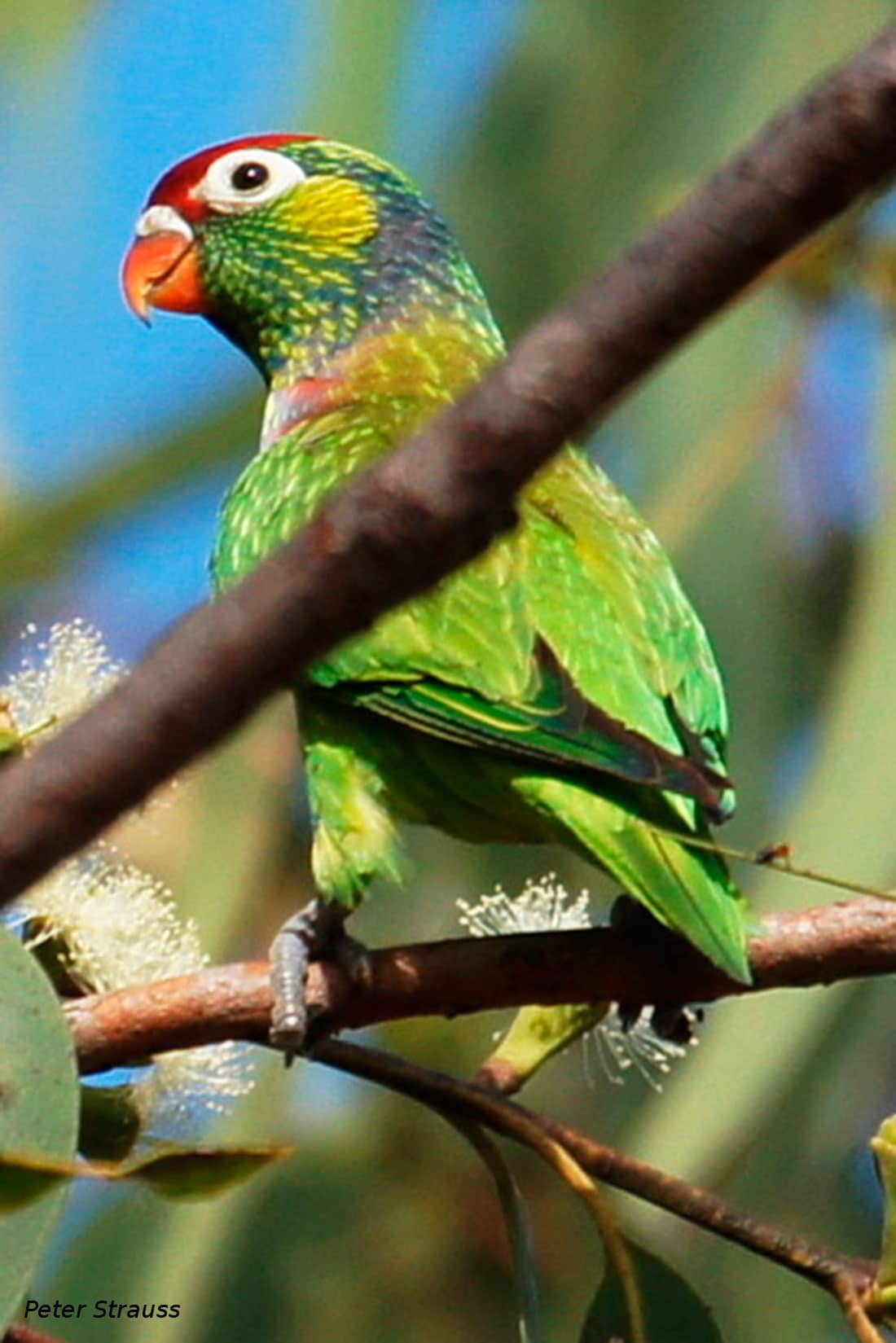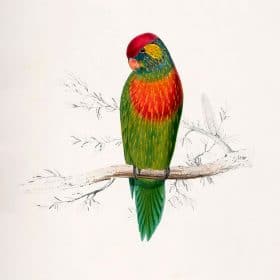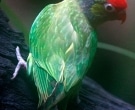Content |
|---|
Description
19 cm.. length and a weight between 50 and 60 gr.
The Varied Lorikeet (Psitteuteles versicolor) has the forecrown and beginning of skull red-scarlet; the mumps and cheeks They are bright yellow-green with a slight bluish green stripe; the back of the mumps and the back of the head They are greenish blue with yellow streaks.
The upperparts They are olive green with pale green streaks along the rump; the Feather coverts are green with a pale border; the flight feather They are blackish green inside and outside with a thin yellow stripe on the edge.
The bottom of the wings It is green with a yellow border; the throat It is dotted with yellow and blue-green; lower throat and the chest show infiltrations green with pink and orange; the abdomen It is pale greenish yellow with yellow stripes.
The upper part of the tail is green, yellow-green below, darker when tail is closed.
The bill is orange. The area covering the nostrils and the bare periophthalmic, are white. The irises It is yellow and legs grey.
The Red coloration of the head on female It is less intensive and extensive. Its chest It is pink with less infiltrations.
In the immature, red color lores and the cap It is absent. The bill It is more marked in brown and irises They are darker.
- Sound of the Varied Lorikeet.
Habitat:
This species lives a nomadic life, mainly on the Plains. It is in a wide variety of forest habitats, including dense eucalyptus plots Melaleuca, swamp forest, savannas and Shrublands, grasslands and sometimes mangroves.
The Varied Lorikeet They also inhabit regions of rolling hills and wooded areas along streams. They live in pairs, in small groups or large groups that are often associated with the Red-collared Lorikee (Trichoglossus rubritorquis), although they have a much calmer demeanor than the latter.
are very aggressive with other species nectarivores that are competing for the same flower beds.
outside the breeding season, the Varied Lorikeet they become more mobile because the blooming trees are rarer. In some areas they are most abundant from April to may and from September to October. But, the information is not sufficient to say that this bird is a seasonal migrant.
Reproduction:
The reproduction It takes place throughout the year, However, It is most active between April and August.
install nest in the cavity of a trunk or branch, usually near a water source. The bottom of the hole is lined with chips of wood or leaves that have been previously “chewed”.
The spawning is between 2 and 5 white eggs that are incubated by the female alone for about 22 days. The young are fed by both parents, and leave the nest after 6 weeks.
Food:
Their diet consists of pollen, fruits, seed and probably some insects. These birds feed on the Ceiba or Kapok, wood and Red eucalyptus trees of Melaleuca.
Distribution:
Size of its range (reproduction / resident): 2.170.000 km2
This bird is endemic in northern Australian continent.
Its area of distribution extends from Broome and the surroundings of the fitzroy river (Western Australia), to the Northwest of Queensland and Mount Isa.
Crosses the region from Kimberley, all the Arnhem Land and in the Gulf of Carpentaria.
The Varied Lorikeet It is also present in the Cape York Peninsula and in the South, Townsville.
Conservation:
• Current IUCN Red List category: Least concern
• Population trend: Stable
The Varied Lorikeet they are usually fairly common. In the Darwin region, for example, It can be found in large quantities when the trees are in bloom. They are less common in the Cape York Peninsula and along the east coast.
The world population It is estimated in more than 100.000 specimens. The species is not globally threatened and does not receive any specific protection measures..
"Varied Lorikeet" in captivity:
It is not found outside Australia; limited breeding in Australia.
Alternative names:
– Varied Lorikeet, Northern Varied Lorikeet (ingles).
– Loriquet varié, Loriquet versicolore (French).
– Buntlori (German).
– Lóris-versicolor (Portuguese).
– Lori Versicolor, Tricogloso Versicolor (español).
scientific classification:
– Order: Psittaciformes
– Family: Psittaculidae
– Genus: Psitteuteles
– Scientific name: Psitteuteles versicolor
– Citation: (Lear, 1831)
– Protonimo: Trichoglossus versicolor
Images “Varied Lorikeet”:
Videos "Varied Lorikeet"
————————————————————————————————
“Varied Lorikeet” (Psitteuteles versicolor)
Sources:
– Avibase
– Parrots of the World – Forshaw Joseph M
– Parrots A Guide to the Parrots of the World – Tony Juniper & Mike Parr
– BirdLife.org
– Photos:
1 – by Peter Strauss – IBC.lynxeds.com
2 – “Psitteuteles versicolor - Queensland-8-4 c” by Psitteuteles_versicolor_-Queensland-8.jpg: Joshua Robertsonderivative work: Snowmanradio (talk) – originally posted to Flickr as Varied Lorikeet [Psitteuteles versicolor] and uploaded to commons at Psitteuteles_versicolor_-Queensland-8.jpg. Licensed under CC BY 2.0 via Wikimedia Commons.
3 – by Steve_Murphy – IBC.lynxeds.com
4 – Varied Lorikeet (Psitteuteles versicolor), Bell Gorge, WA – olsvik.info
5 – Alan Marshall’s Pictures of Varied Lorikeet – members.ozemail.com.au
6 – Varied Lorikeet (Psitteuteles versicolor) Illustration by Edward Lear [Public domain], via Wikimedia Commons







